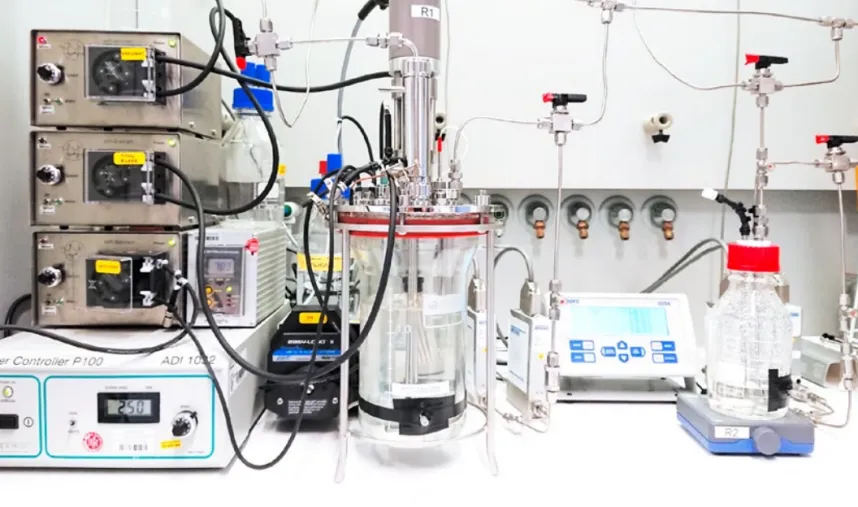Microbiology
In the Microbial Physiology Group, which is based at the Max Planck Institute for Marine Microbiology, we discover new biochemical pathways, and aim to fundamentally understand the physiology and interactions of microorganisms that govern global carbon and nitrogen cycles.
In bioreactor systems that we design and optimize, we cultivate and perform experiments on microorganisms under controlled conditions, which closely mimic their natural environment. We analyze the resulting cultures using omics, biochemical and physiological approaches. The information we acquire is vital to understand carbon and nitrogen cycling on present-day earth and the impact of human activities on these cycles. Moreover, through our results we gain insights into the evolution of carbon- and nitrogen-transforming pathways.
The natural environment can be mimicked very closely in a laboratory-scale bioreactor. In the bioreactor depicted here, microorganisms extract energy from nitric oxide, and thus essentially breathe poison.
- Between 2019 and 2022, we published 17 peerreviewed scientific papers.
- National and international media reported on our papers on nitric-oxide-dependent anaerobic ammonium oxidation and on the discovery of a new nitric-oxide-producing enzyme. The press included German, Italian and American news organizations. Furthermore, American Chemical Society, Dutch Chemical Society, Le Scienze, Phys.org and Focus Magazine highlighted our work.
- Two group members won the prizes for best oral and poster presentations at the 25th European Nitrogen Cycle Meeting in Rome.
Currently, the Microbial Physiology Group at the Max Planck Institute for Marine Microbiology comprises two postdoctoral fellows, three PhD students, and one technical assistant. The group has been funded by Max Planck Society, Netherlands Organisation for Scientific Research, China Scholarship Council, and European Research Council Starting Grant.
- Hu Z., H. J. C. T. Wessels, T. van Alen, M. S. M. Jetten, B. Kartal. 2019. Nitric oxide dependent anaerobic ammonium oxidation. Nature Communications, 10:1910.
- Ferousi C., S. Lindhoud, F. Baymann, E. R. Hester, J. Reimann, B. Kartal. 2019. Discovery of a functional, contracted heme-binding motif within a multiheme cytochrome. Journal of Biological Chemistry, 294:16953 – 16965
- Versantvoort W., A. Pol, M.S.M. Jetten, L. van Niftrik, J. Reimann, B. Kartal, H. J. M. op den Camp. 2020. Multiheme hydroxylamine oxidoreductases produce NO during ammonia oxidation in methanotrophs. Proceedings of the National Academy of Sciences of the United States of America, 117:24459-24463.
- Chicano T.M., L. Dietrich, N. M. de Almeida, M. Akram, E. Hartmann, F. Leidreiter, D. Leopoldus, M. Mueller, R. Sanchez, G. H. L. Nuijten, J. Reimann, K. A. Seifert, I. Schlichting, L. van Niftrik, M. S. M. Jetten, A. Dietl, B. Kartal, K. Parey, T. R. M. Barends. 2021. Structural and functional characterization of the intracellular filament-forming nitrite oxidoreductase multiprotein complex. Nature Microbiology, 6:1129-1139.
- Ferousi C., R. A. Schmitz, W. J. Maalcke, S. Lindhoud, W. Versantvoort, M. S. M. Jetten, J. Reimann, B. Kartal. 2021. Characterization of a nitrite-reducing octaheme hydroxylamine oxidoreductase that lacks the tyrosine cross-link. Journal of Biological Chemistry, 296:100476

